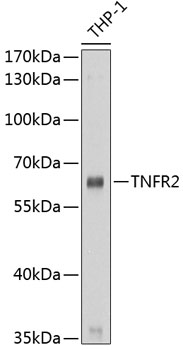TNF-α is an important cytokine produced by numerous cell types including neutrophils, activated lymphoctyes, macrophages an NK cells. It plays a critical role in inflammatory responses and in apoptosis (1). TNF-α exists as a membrane-anchored and soluble form, both of which show biological activity. Response to TNF-α is mediated through two receptors, TNF-R1, which is widely expressed, and TNF-R2, which is expressed mainly in immune and endothelial cells (2). Antagonists to TNF-α have been validated as therapeutic targets for rheumatoid arthritis and other immune disorders (3).
The two receptors for TNF-α, TNF-R1 (55 kDa) and TNF-R2 (75 kDa) can mediate distinct cellular responses (4,5). In most cases cytotoxicity elicited by TNF has been reported to act throught TNF-R1 (6,7). In contrast, TNF-R2 appears to be important in T cell signaling and responses to infection (7,8). TNF-R2 binds to distinct members of the TRAF family leading to the activation of NF-κB (9,10). Soluble forms of both receptors have also been characterized which can bind TNF-α and may play an important role in immune disorders (11,12).

